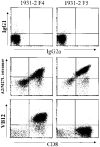Generation of tumor-infiltrating lymphocyte cultures for use in adoptive transfer therapy for melanoma patients
- PMID: 12843795
- PMCID: PMC2305721
- DOI: 10.1097/00002371-200307000-00005
Generation of tumor-infiltrating lymphocyte cultures for use in adoptive transfer therapy for melanoma patients
Abstract
The generation of T lymphocytes with specific reactivity against tumor antigens is a prerequisite for effective adoptive transfer therapies. Melanoma-specific lymphocyte cultures can be established from tumor infiltrating lymphocytes (TILs) by in vitro culture in high levels of IL-2. We have optimized methods for generating melanoma-reactive TIL cultures from small resected tumor specimens. We report a retrospective analysis of 860 attempted TIL cultures from 90 sequential melanoma biopsy specimens from 62 HLA-A2+ patients. Multiple independent TIL derived from a single tumor often exhibited substantial functional and phenotypic variation. Tumor specific activity was detected in TIL from 29 (81%) of 36 patients screened. TIL cultures selected for high activity were generally capable of large numerical expansion using a single round of a rapid expansion protocol. Limited clonal T-cell populations in an oligoclonal TIL culture could confer specific tumor recognition in these highly selected, highly expanded TIL cultures. These methods were efficient at generating TILs suitable for adoptive transfer therapy.
Figures


References
-
- Rosenberg SA, Yannelli JR, Yang JC, et al. Treatment of patients with metastatic melanoma with autologous tumor- infiltrating lymphocytes and interleukin 2. J Natl Cancer Inst. 1994;86:1159–1166. - PubMed
-
- Riddell SR, Watanabe KS, Goodrich JM, et al. Restoration of viral immunity in immunodeficient humans by the adoptive transfer of T cell clones. Science. 1992;257:238–241. - PubMed
-
- Rooney CM, Smith CA, Ng CY, et al. Infusion of cytotoxic T cells for the prevention and treatment of Epstein-Barr virus-induced lymphoma in allogeneic transplant recipients. Blood. 1998;92:1549–1555. - PubMed
-
- Dudley ME, Wunderlich J, Nishimura MI, et al. Adoptive transfer of cloned melanoma-reactive T lymphocytes for the treatment of patients with metastatic melanoma. J Immunother. 2001;24:363–373. - PubMed
MeSH terms
Substances
Grants and funding
LinkOut - more resources
Full Text Sources
Other Literature Sources
Medical
Research Materials

